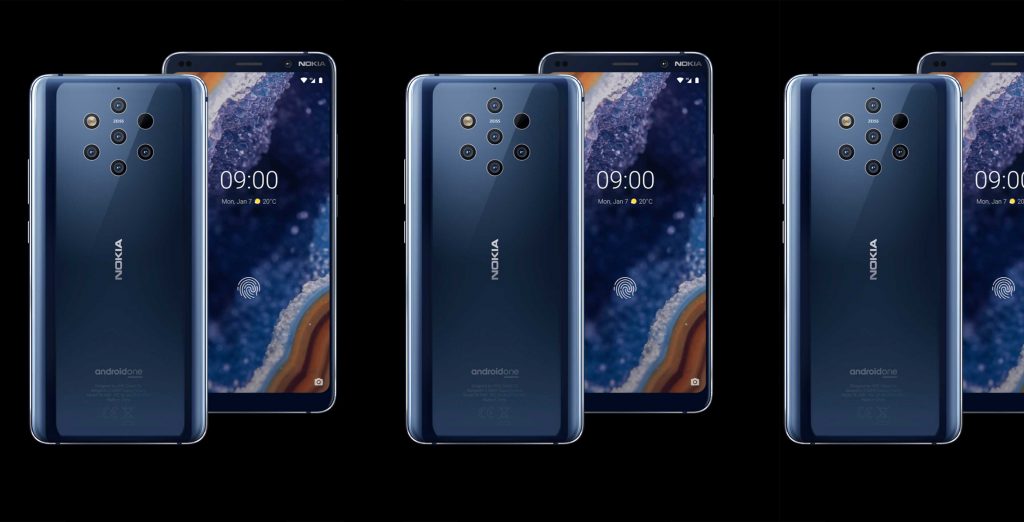
The Nokia 9 PureView has five rear cameras and that doesn’t even seem like that big of a deal. The anticipated Nokia 9 PureView is HMD Global’s newest and boldest flagship phone under the Nokia brand the Finnish startup acquired several years ago. A word of warning: HMD says this phone is a “limited edition,” being offered in a limited run. But it should be coming to the Nigeria (the phone costs €599, or $699, roughly converting to N249,000).
It’s five Zeiss camera lenses, but it looks like seven in a ring, like a spider’s eyes. Three are 12-megapixel monochrome cameras, two are 12-megapixel RGB cameras, all f/1.8, 28mm. One spot is a flash, and the other is a time-of-flight sensor for depth mapping.
It’s the first five-rear-camera phone. But is that even a big distinction, now? The Samsung Galaxy S10 has three rear cameras (and four on the upcoming 5G version), and a total of six cameras inside and out of the Galaxy Fold.

Nokia’s cameras don’t do extra levels of optical zoom. Instead, they’re all meant to capture a massive amount of data for HDR and depth based photography. The camera array was partially developed by Light, the company that also made the wild 16-lens L16 camera, and has recently announced a partnership to develop more computational photography products with Sony image sensors.
Light’s initial 16-lens standalone camera vision was to offer up a Swiss army knife of options for any photo need. Light’s L16 camera was reviewed to some disappointment when it debuted, but hinted at a multi-camera phone future. Light was expected to release a phone with nine cameras last year.

Against those devices, the five-camera Nokia 9 PureView seems tame by comparison, but this phone aims for computational advantages over other phone cameras. In a brief hands-on with the phone, I tried shooting some photos. Images looked sharp, but photo processing seemed to take a long time (HMD said that’s being improved before release).
The photos taken with the Nokia 9 PureView can be depth-edited after the fact by tapping anywhere on the photo, and works with depth editing on Google Photos, so uploaded photos can still be depth-edited, too.

The depth map on photos taken with the Nokia 9 is 12 megapixels, with 1,200 layers of depth data, according to HMD. The phone takes five minimum exposures, captures around 60 to 240 megapixels of data and reduces it back to a 12 megapixel photo. Photos can also be taken in RAW DNG format, but blend a composite of the images taken with all cameras, with a varying file size around 30MB.
Adobe Lightroom will edit the phone’s DNG photos, and will come with custom lens profiles “tuned specifically” for the phone.
The Nokia 9 PureView claims better HDR shots than the competition with all those cameras, and a dedicated monochrome mode. And photos can have multiple focal points in bokeh shots, meaning that bottles or light bulbs at different distances can be in focus at the same time. How much better will they be? Check out a sample photo below, which was one of the only ones HMD Global shared of the shots I took.

The rest of the phone: more straightforward
This phone doesn’t sport a new Qualcomm Snapdragon 855 processor; instead, it has a Snapdragon 845 that Qualcomm’s representatives say is fully utilized to process the phone’s photos, plus a dedicated Light Camera Lux Capacitor processor in the phone. This is also an Android One phone like the Nokia 8.1 and 7.1, which means it’ll have two years of guaranteed Android updates and regular security updates.
The phone also has a 20-megapixel front-facing camera, a 5.99-inch 2K pOLED display, an under-the-screen fingerprint reader, face unlock via the phone’s front camera, wireless charging and IP67 water resistance. At least all those rear cameras are flush with no camera bump.
Whether you crave the Nokia 9 PureView really depends on whether you want to play with a five-camera computational camera for HDR and depth, or prefer something like a good old everyday three-camera variable zoom lens phone. It’s only a matter of time before someone decides to go to six cameras, or seven or nine. If camera lenses are like razor blades, the Nokia 9 PureView has earned a novelty spot for now… but that moment probably won’t last very long.
HMD Global has already indicated that the company plans to release about a phone a month, and the Nokia 9 PureView is one of five phones the company’s announced at Mobile World Congress, after debuting two other phones just a few weeks ago. At this rate, if you’re waiting for another exciting Nokia phone, maybe just wait another month.
What I really want to see is the full 16-camera Light camera vision on a phone next.
Specs:
- Qualcomm Snapdragon 845
- 5.99 inch 2K QHD pOLED display
- 6GB RAM
- Five rear cameras plus time of flight sensor (Three 12-megapixel monochrome, two 12-megapixel RGB)
- 20-megapixel front camera
- 128GB storage
- A single color: Midnight Blue
- 8mm thick
- 172g
- IP67 water resistance
- Gigabit LTE
- 3,320 mAh battery
- Wireless charging
- Gorilla Glass 5
- Under-screen fingerprint sensor, face unlock via front camera
- USB-C
- 18W fast charging
- No headphone jack
